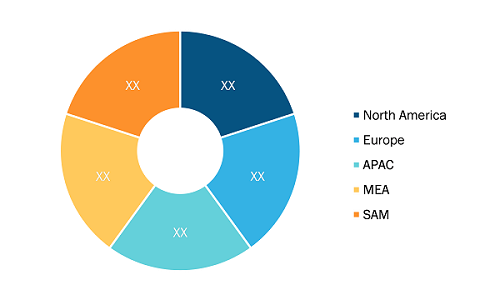The global virtual pipeline systems market size is expected to reach US$ 1,886.83 million by 2028, registering at a CAGR of 9.2% from 2022 to 2028, according to a new research study conducted by The Insight Partners.
Growing Inclination Toward Consumption of Natural Gas Provide Lucrative Opportunities for Virtual Pipeline Systems Market
Increased investments in natural gas research and development by oil & gas and energy businesses are anticipated to provide significant opportunities for the future growth of companies in the virtual pipeline system market. These R&D activities are mainly driven by their goal of promoting the use of low-emission natural gas products. Virtual pipeline vendors focus on technological innovations, new product launches, product approvals, and geographic expansion to capture larger consumer and market base volume. In September 2019, Quantum Fuel Systems announced that it would build 40-foot virtual pipeline trailers, including 45 tanks with a gas capacity of ~471,000 cubic feet. The new VPLite45/40 virtual pipeline trailer was scheduled for launch in the first quarter of 2020. Similarly, in January 2022, Enric delivered 40 CNG and LNG semi-trailers to various African regions to provide support and service guarantees for developing natural gas in Africa. Furthermore, countries in Asia Pacific have significantly transitioned toward natural gas consumption. For instance, Malaysia is on course to becoming an LNG bunkering hub, with Petronas' first LNG bunkering vessel (LBV). Malaysia is also expected to increase gas supply via its virtual pipeline system (VPS). In September, national gas company Petronas launched its first LNG VPS solution in Peninsular Malaysia via the regasification terminal in Pengerang, Johor. This follows the earlier success of micro-LNG VPS facilities by Sabah Energy Corp at the Kota Kinabalu Industrial Park (KKIP) that serves the Sabah state. Further, aging pipeline infrastructure has been a major concern for governments worldwide. As a result, they are striving to find alternatives to conventional methods of oil and gas transportation.
Virtual Pipeline Systems Market Share – by Region, 2021
Virtual Pipeline Systems Market Size and Forecast (2021 - 2031), Global and Regional Share, Trend, and Growth Opportunity Analysis Report Coverage: By Type (Standard Trailer and Towable Trailer), Gas (CNG, Hydrogen, and Others), Pressure Rating (Less Than 3000 Psi, 3001 to 5000 Psi, and More Than 5000 Psi), and Application (Industrial, Transportation, Commercial, and Residential), and Geography
Virtual Pipeline Systems Market Growth Report and Size - 2031
Download Free Sample
Source: The Insight Partners Analysis
The major stakeholders in the global virtual pipeline systems market ecosystem include natural gas production, transportation by pipeline, liquefaction at an LNG facility, shipping by an LNG carrier, and regasification at an LNG facility. The chain starts with the exploration and production of natural gas. It includes extracting unprocessed natural gas from gas reserves, rough on-site processing, and bringing the gas from the site of extraction to a processing facility. LNG is most transported in large quantities by designated ships called LNG carriers.
The virtual pipeline systems market has been analyzed based on the following segments—type, gas, pressure rating, application, and geography. Based on type, the market is segmented into below standard trailer and towable trailer. The below standard trailer segment accounted for a larger share of the market. Based on gas, the market is segmented into CNG, hydrogen, and others. The CNG segment accounted for the largest share of the virtual pipeline systems industry. Based on pressure rating, the market is segmented into less than 3000 Psi, 3001 Psi to 5000 Psi, and more than 5001 Psi. The 3001 Psi to 5000 Psi segment held the largest share of the virtual pipeline systems industry. Based on application, the virtual pipeline systems industry is segmented into industrial, transportation, and commercial & residential. The transportation segment accounted for the largest share of the virtual pipeline systems market. In terms of geography, the market is divided into five regions North America, Europe, Asia Pacific, the Middle East & Africa, and South America. Asia Pacific dominated the virtual pipeline systems market in 2021, and North America held the second-largest market share in 2021.
Impact of COVID-19 Pandemic on Virtual Pipeline Systems Market
The COVID-19 pandemic negatively affected the global virtual pipeline systems industry. The demand for liquid natural gas and hydrogen gas fell sharply due to lockdowns and travel bans in various parts of the world, especially China, India, and Europe. This decline in demand for LNG has prompted a reduction in the requirement for towable trailers and truck carriers in the market. During the COVID-19 pandemic, lockdowns slowed shipbuilding and construction of pipeline projects in the works, and companies delayed final investment decisions (FIDs) on potential natural gas and hydrogen supply projects by several years. Therefore, the global virtual pipeline systems market could face a supply shortfall in a few years, which appeared unlikely at the start of 2020 when planned projects with 186 million tons of capacity were in the pipeline.
Bayotech, Inc; CNG Services Ltd; Petroliam Nasional Berhad (PETRONAS); RAG Austria AG; Quantum Fuel Systems LLC; Galileo Technologies S.A.; Chart Industries, Inc.; SHIJIAZHUANG ENRIC GAS EQUIPMENT CO., LTD; Fiba Technologies Inc; Hexagon Agility; and Composite Advanced Technologies, LLC are among the key players operating in the virtual pipeline systems market. In addition, several other market players have been analyzed to understand the virtual pipeline systems market.
Contact Us
Phone: +1-646-491-9876
Email Id: sales@theinsightpartners.com